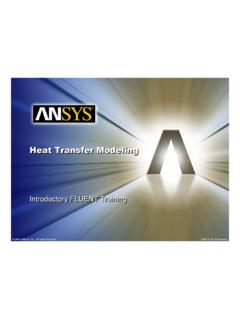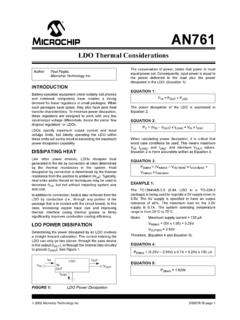Transcription of 1 Classification of Heat Exchangers
1 1 Classification of heat ExchangersA variety of heat Exchangers are used in industry and in their products. The objective ofthis chapter is to describe most of these heat Exchangers in some detail using classificationschemes. Starting with a definition, heat Exchangers are classified according to transferprocesses, number of fluids, degree of surface compactness, construction features, flowarrangements, and heat transfer mechanisms. With a detailed classification in each cate-gory, the terminology associated with a variety of these Exchangers is introduced andpractical applications are outlined. A brief mention is also made of the differences indesign procedure for the various types of heat INTRODUCTIONA heat exchangeris a device that is used to transfer thermal energy (enthalpy) betweentwo or more fluids, between a solid surface and a fluid, or between solid particulates anda fluid, at different temperatures and in thermal contact.
2 In heat Exchangers , there areusually no external heat and work interactions. Typical applications involve heating orcooling of a fluid stream of concern and evaporation or condensation of single- ormulticomponent fluid streams. In other applications, the objective may be to recoveror reject heat , or sterilize, pasteurize, fractionate, distill, concentrate, crystallize, or con-trol a process fluid. In a few heat Exchangers , the fluids exchanging heat are in directcontact. In most heat Exchangers , heat transfer between fluids takes place through aseparating wall or into and out of a wall in a transient manner. In many heat Exchangers ,the fluids are separated by a heat transfer surface, and ideally they do not mix or Exchangers are referred to asdirect transfer type, or simplyrecuperators.
3 In con-trast, Exchangers in which there is intermittent heat exchange between the hot and coldfluids via thermal energy storage and release through the exchanger surface or matrix are referred to asindirect transfer type, or simplyregenerators. Such Exchangers usuallyhave fluid leakage from one fluid stream to the other, due to pressure differences andmatrix rotation/valve switching. Common examples of heat Exchangers are shell-and-tube Exchangers , automobile radiators, condensers, evaporators, air preheaters, andcooling towers. If no phase change occurs in any of the fluids in the exchanger, it issometimes referred to as asensible heat exchanger. There could be internal thermalenergy sources in the Exchangers , such as in electric heaters and nuclear fuel and chemical reaction may take place within the exchanger, such as inboilers, fired heaters, and fluidized-bed Exchangers .
4 Mechanical devices may be used insome Exchangers such as in scraped surface Exchangers , agitated vessels, and stirred tankreactors. heat transfer in the separating wall of a recuperator generally takes place by1conduction. However, in a heat pipe heat exchanger, the heat pipe not only acts as aseparating wall, but also facilitates the transfer of heat by condensation, evaporation,and conduction of the working fluid inside the heat pipe. In general, if the fluids areimmiscible, the separating wall may be eliminated, and the interface between the fluidsreplaces a heat transfer surface, as in a direct-contact heat OF heat EXCHANGERSFIGURE Classification of heat Exchangers (Shah, 1981).A heat exchanger consists ofheat transfer elementssuch as a core or matrix containingthe heat transfer surface, andfluid distribution elementssuch as headers, manifolds,tanks, inlet and outlet nozzles or pipes, or seals.
5 Usually, there are no moving parts ina heat exchanger; however, there are exceptions, such as a rotary regenerative exchanger(in which the matrix is mechanically driven to rotate at some design speed) or a scrapedsurface heat heat transfer surface is a surface of the exchanger core that is in direct contactwith fluids and through which heat is transferred by conduction . That portion of thesurface that is in direct contact with both the hot and cold fluids and transfers heatbetween them is referred to as theprimaryordirect surface. To increase the heat transferarea, appendages may be intimately connected to the primary surface to provide anextended,secondary,orindirect surface. These extended surface elements are referredto asfins.
6 Thus, heat is conducted through the fin and convected (and/or radiated) fromthe fin (through the surface area) to the surrounding fluid, or vice versa, depending onwhether the fin is being cooled or heated. As a result, the addition of fins to the primarysurface reduces the thermal resistance on that side and thereby increases the total heattransfer from the surface for the same temperature difference. Fins may form flowpassages for the individual fluids but do not separate the two (or more) fluids of theexchanger. These secondary surfaces or fins may also be introduced primarily for struc-tural strength purposes or to provide thorough mixing of a highly viscous only are heat Exchangers often used in the process, power, petroleum, transpor-tation, air-conditioning, refrigeration, cryogenic, heat recovery, alternative fuel, andmanufacturing industries, they also serve as key components of many industrial productsavailable in the marketplace.
7 These Exchangers can be classified in many different will classify them according to transfer processes, number of fluids, and heat transfermechanisms. Conventional heat Exchangers are further classified according to construc-tion type and flow arrangements. Another arbitrary classification can be made, based onthe heat transfer surface area/volume ratio, into compact and noncompact heat exchan-gers. This classification is made because the type of equipment, fields of applications, anddesign techniques generally differ. All these classifications are summarized in Fig. anddiscussed further in this chapter. heat Exchangers can also be classified according to theprocess function, as outlined in Fig.
8 However, they are not discussed here and thereader may refer to Shah and Mueller (1988). Additional ways to classify heat exchangersare by fluid type (gas gas, gas liquid, liquid liquid, gas two-phase, liquid two-phase,etc.), industry, and so on, but we do not cover such classifications in this CLASSIFICATION ACCORDING TO transfer PROCESSESHeat Exchangers are classified according to transfer processes into indirect- and direct-contact Indirect-Contact heat ExchangersIn an indirect-contact heat exchanger, the fluid streams remain separate and the heattransfers continuously through an impervious dividing wall or into and out of a wall in atransient manner. Thus, ideally, there is no direct contact between thermally interactingfluids.
9 This type of heat exchanger, also referred to as asurface heat exchanger, can befurther classified into direct- transfer type, storage type, and fluidized-bed ACCORDING TO transfer Direct- transfer Type this type, heat transfers continuouslyfrom the hot fluid to the cold fluid through a dividing wall. Although a simultaneousflow of two (or more) fluids is required in the exchanger, there is no direct mixing of thetwo (or more) fluids because each fluid flows in separate fluid passages. In general, thereare no moving parts in most such heat Exchangers . This type of exchanger is designatedas a recuperative heat exchanger or simply as arecuperator.{Some examples of direct- transfer type heat Exchangers are tubular, plate-type, and extended surface that the termrecuperatoris not commonly used in the process industry for shell-4 CLASSIFICATION OF heat EXCHANGERSFIGURE (a) Classification according to process function; (b) classification of condensers;(c) classification of liquid-to-vapor phase-change Exchangers .}
10 {In vehicular gas turbines, a stationary heat exchanger is usually referred to as arecuperator, and a rotating heatexchanger as aregenerator. However, in industrial gas turbines, by long tradition and in a thermodynamic sense, astationary heat exchanger is generally referred to as a regenerator. Hence, a gas turbineregeneratorcould be eithera recuperator or a regenerator in a strict sense, depending on the construction. In power plants, a heat exchanger isnot called a recuperator, but is, rather, designated by its function or and plate heat Exchangers , although they are also considered as are further subclassified as prime surface Exchangers and surface exchangersdo not employ fins or extended surfaces on anyfluid side.}














